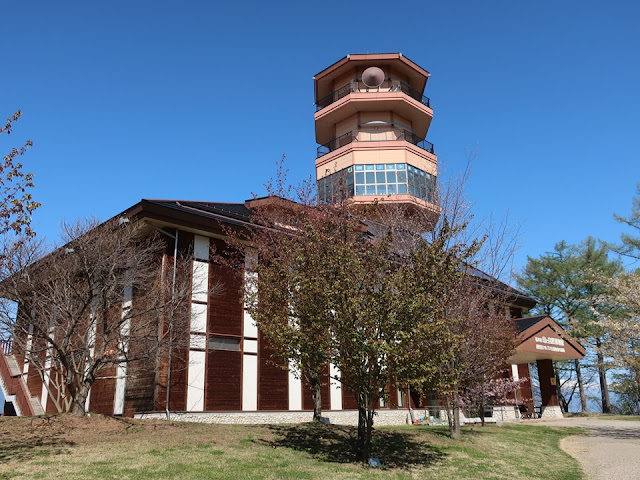The museum is located at the hill of Matsumoto
City in Nagano Prefecture. The city is surrounded by high mountains.
Although the museum mainly displays animals and plants in mountains, I
highlight local lives which is a theme of this blog.
松本市のアルプス公園に立つ博物館です。岳都・松本の動植物を展示していますが、その中から人の暮らしに関わるものを紹介します。
The day I visited in April was perfect! I
could enjoy the view of Matsumoto Basin and Northern Japan Alps. In the
movie, you can see whole view.
まずは、展望台からの景色から。訪問した日は快晴で松本平と北アルプスを一望できました。動画も付けます。
一階と二階が博物館で、全面ガラス窓の四階が展望室です。無線中継所でもあります。
The green doll at the center of the exhibition room is Dedarabotchi which is the giant in the legend. Four sections about four seasons are located around it.
展示室の中央にデーダラボッチの人形があり、それを囲んで、春夏秋冬の四つのコーナーがあります。
Spring section、春のコーナー
松本は標高約600m。寒い土地です。春は、「水ぬくみ、いのちが目覚める季節」。嬉しい季節ですね。水辺の生き物が紹介されています。
People in Matsumoto used to buy carps and release them to the rice fields in Jun. Not only carps eat weed, but also they warm the water. In the autumn, carps grow to around 20cm. People catch them, grill them and dry them; those are preserved food for winter.
People eat carp miso soup (Koikoku), too. Some people kept carps in a neighboring pond and ate them on the festival days or when guests came. It's very useful.
松本では6月頃に鯉を買って来て、田んぼに放しました。鯉は、小さい草を食べるだけでなく、水を温めてくれるそうです。※(日本語のみ追記)日本の食文化(成城大学民俗学研究所編_1990)の岡山県平川村の項には、「鯉の子を春先に購入して、田にはなしてみる人が点々あるが、・・・秋、水を落とした時には二、三匹ぐらいしか残っていない有様である」と書かれています。松本の気候が良かったのか、大切に育てたのか。鯉を放せば良いというものではなさそうです。
秋口に20cmぐらいに育つと、串焼きにしてから干し、保存食にしたそうです。鯉コクも食べましたが、近所のため池に預けておいて、必要な時にさばいて食べることもあったそうです。鯉はハレの日の食材ですからね。
Summer section、夏のコーナー
Creatures in high lands such as a Raichou bird(Rock ptarmigan) are exhibited.
雷鳥など高山の生物が展示されています。
Autumn section、秋のコーナー
Mountains in autumn give us foods such as chestnuts. Creatures in mountains like a bear are exhibited.
秋の山は恵みの森。なるほど。熊など山に住む生き物たちが展示されていました。
Winter section、冬のコーナー
Creatures in forests such as a rabbit are exhibited. Woodland surrounded a village is called “Sato (village) -yama (mountain)” in Japanese. Sato-yama was very important because it used to supply food (mushrooms, wild plants, nuts), firewood and so on. However, people don’t maintain sato-yama (for example, removing underbrush), so it is written that creatures in sato-yama is losing their habitat and is facing to extinction.
野ウサギなど里の生物が展示されています。里山が放置され森林化しつつある今、里の動植物は絶滅の危機に瀕していると書かれていました。
Exhibition room in the 2nd floor、二階展示室
Abundant insect and botanical specimens are displayed.
大量の昆虫や植物の標本が展示されています。
There is a section of the mountain-climbing. A holy monk Banryu made the first ascent of Mt. Yari (3,180m, “Yari” means a spear) in 1828, which has a spearhead shaped summit. A local guided him. In 1840, iron chains were set at rocky area. Many people probably climbed. I wonder whether they climbed due to faith or fun.
登山の資料も展示されていますよ。富山市出身の念仏行者の播隆上人は、地元の中田又重郎さんの案内で、1828年に槍ヶ岳に初登頂しました。1840年には岩場に鉄鎖がかけられました。山岳信仰なのか、実は楽しみの登山なのか。
In the late 19th century, many Westerners began to visit Japan. Afterward, mountain-climbing for faith changed to it for fun.
信仰のための登山が、楽しみのための登山に変わったのは、西洋人が日本に住み始めた明治時代以降です。
There are plenty of exhibits about mountain-climbing equipment such as tent. The leftmost winter coat is made of a bear fur. It changed to a down coat as time goes by.
登山道具の展示も充実しています。テントの展示されていました。左端は、熊の皮の防寒着です。左側から右側に向けて、新しい装備を展示しています。
Visited in April, 2021
Official website: https://matsu-haku.com/yamatoshizen/
(in Japanese), accessed in March, 2022
Previous post (Folklore museum in the
neighboring city, Azumino): Toyoshina Local Museum、豊科郷土博物館
Next post (Preserved building in the same city, Matsumoto): Former Yamabe School、旧山辺学校校舎












Comments
Post a Comment